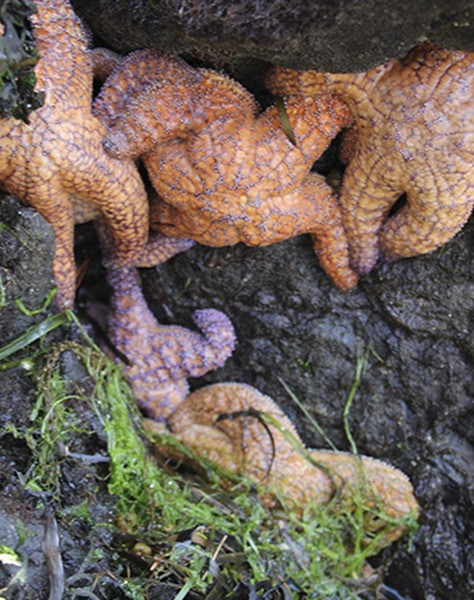by ANNA MEYER
Special to the Sounder
Touching sea stars sheltering during low tide will reveal not sturdy, sandpiper skin but a soft and pulpy texture with white and oozing lesions, its limp, weakened rays and strained tube feet unable to grasp at craggy surfaces. But what has caused such a gruesome change in our ochre sea stars?
“We’re hopeful but not sure the cause for optimism is entirely warranted – yet,” said Dr. Christopher Mah, research collaborator at the Smithsonian Museum of Natural History.
Ochre sea stars, along with other asteroid sea stars, are suffering from sea star wasting disease, a terminal disease that quickly leads to the dissolution and death of affected sea stars. According to a study by the University of Santa Cruz, the sea star “melts” into a white mucus-like paste in just a few days. The slow degeneration and graphic death of several species of sea stars has drawn concerned marine scientists from across the nation to focus on the potential causes of this disease.
The first major breakout of wasting disease was first noticed in 1972, when sea stars began to show symptoms on the East Coast. In 1982, stars in California began to decline, seemingly also from wasting disease. Finally, in 2013, massive die-offs began to happen on both the East and West Coasts. Scientists began to study affected sea stars in depth to discover what was causing this unknown and disconcerting disease. Wasting disease showed signs of being caused by something microscopic and transmittable, like a virus or bacteria. This year, two years after the start of the outbreaks, scientists are releasing publications on a major causative agent of sea star wasting disease – a virus.
A collection of marine scientists released a publication in December of 2014 showing that affected sea stars were carrying a densovirus, and that this was most likely causing the sea star wasting and die-offs.
According to an article in National Geographic, a densovirus is a small single-strand virus of the same family that infects dogs with canine parvovirus. The study showed that sea stars with more viral particles in their bodies were more likely to dissolve and die. Since the disease is due to a virus, this means it is easily transmitted via water carrying viral particles or via infected individuals and is difficult to treat. Infected water must be treated with ultraviolet rays or otherwise disinfected to effectively abolish the viral particles. This means that there is no straightforward method for treating sea stars or outbreaks in the wild.
Without a direct way to treat this virus, scientists are resorting to determining the impacts on sea star populations. Studies suggest that stress (from heat, unsheltered habitat or other environmental conditions) may increase the incidence of sea stars contracting the virus – meaning that higher water temperatures associated with summer may increase the prevalence of wasting sea stars.
Although the major causative agent of the virus has seemingly been pinpointed, scientists are still looking into this disease. Temperature relations, species links and environmental factors are all still potentially factors in the intensity of wasting disease outbreaks. The viral factor is being treated as a piece of a larger puzzle. “There’s a possibility it could be very complicated,” said Mah. “Other invertebrate diseases are not easily understood.” He described coral bleaching, which is caused by microbial imbalances on the skin of various coral species as an example of the complex nature of marine invertebrate diseases.
What scientists are focused on – more than temperature and environment – is the sheer number of sea stars affected. Without an accurate idea of how badly sea stars are being hit by this disease, further decisions regarding protection and management cannot be made with certainty.
The University of California at Santa Cruz has reported areas with wasting occurring between 5 to 60 percent in areas along the West Coast.
On Orcas Island, Kwiaht, a noprofit focused on the health of the San Juan Islands, has reported 2015 mortality rates for ochre sea stars at Indian Island at around 8 percent.
The mortality rate may even be lower than that.
“Healthier stars are more likely to move deeper to avoid sun and heat because they are more mobile than sick animals,” said Russel Barsh, director of Kwiaht.
He does caution that sea star mortality may rise somewhat during summer months when sea stars are subjected to more stress.
Recent reports are hopeful, despite the relatively sudden onset of wasting disease and its complicated nature. Scientists at UCSC are reporting juvenile sea stars in some of their study sites, and juveniles were seen by Kwiaht members on Indian Island this summer. Despite the signs of prospective recovery, scientists press for moderation.
It is likely that there are several more factors at play than just viral infection: what those factors are still to be determined.
Although hopeful, Russel Barsh counsels, “We’re not necessarily out in the clear.”



